The Cobra has done its job
this weekend!
Photo by Unique Angle


|
However, I think I could have gone faster; in the session in which I set my fastest lap, I was held up for almost the entire session by another car - one that's previously always been faster than me.
In the time trial I took second, beaten only by a much lighter car with much more power than mine.
Starting after our first track event in August 2000, only four days after the Cobra hit the road, Nate and I began to develop its suspension to improve its handling and grip. You can read about many of the modifications that we made on my Tweaks page.
Over the past three years, we have upgraded the car's springs and shocks, designed and built front and rear anti-roll bars, converted the rear spindles from rubber bushings to spherical bearings, and made several other changes. Now, the only major suspension tweak left (short of changing the geometry, which I'm not ready to do yet) was to eliminate the urethane bushings in the front suspension.
This would have several benefits. During my research on suspension tweaks, Doug Arnao said that one important goal was to have all the suspension arms move so freely that they pivoted super-smoothly, "like buttah". This would allow the shocks to do their job properly. If there's friction in the pivots, this adds extra, uncalibrated friction damping to the carefully controlled hydraulic damping performed by the shocks, which somewhat compromises their effectiveness. Eliminating the urethane bushings would reduce friction, since metal on metal rod end (aka Heim joint) bearings would have less friction, especially under load, than the urethane bushings running over steel sleeves.
Another important goal was to try to get the front tires' working camber into a range where the tire contact patch is being used more effectively. One of the major issues with the FFR front suspension design is that it tends to run the front tires on their outer edges rather than flat on the road surface. On the track, FFR cars always heat up the outer edge of the front tires, while the inner edges run relatively cool. On the street as well as on the track, the outer edge of the tire wears out much sooner than the inside edge.
One way to address this is to add more static camber and more caster, which tilts the top of the tire inboard (this is called negative camber) and puts more load on the inner edge of the tire. I switched to power steering earlier this summer in order to be able to run more caster, and it did help some.
However, I couldn't add as much camber or caster as I wanted because the coil spring would have interfered with the inside of the upper control arm. I needed to tilt the top of the spring/shock unit slightly inboard - but I couldn't do that because the bottom of the shock (a specially machined aluminum "hat" which allowed mounting the beefy 2" Bilstein shocks) would then interfere with the crossbar on lower A-arm.
At the same time, I figured that the urethane bushings on the inboard end of the lower control arm were compressing under load, allowing the lower control arm to move inboard, giving up negative camber just when it was needed most.
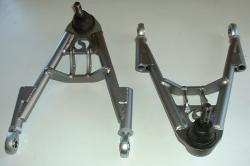
|
This was great! If I got new control arms and converted them to rod end bearings on the inboard end, I'd kill three birds with one stone: more shock clearance, allowing me to tilt the spring/shock units so I could get more camber and caster; no compliance, thus keeping the working camber where I wanted it; and less friction.
Jim kindly took a set of the control arms off the FFR production line before the inner sleeves had been welded on, and before they were powder coated. I took some measurements and had some tap tube welded onto the ends at 90° from the normal angle of the urethane bushings. I had the tap tube tapped to accept 3/4" rod ends with a 5/8" shank - the same size rod ends that are used on the FFR IRS control arms.
I arranged things so the tap tubes and rod ends are at 90° from the centerline of the pivot bolts because this should minimize wear in the rod ends. I'm using teflon-lined rod ends so I don't have to use dirt-attracting grease, but by keeping the race and ball running over the same area, there will be less tendency for dirt to work into the space between the ball and race. This is the way it seems to be done on most pure race cars.
Having seen a Mustang which crashed heavily at Lime Rock a couple of years ago when its fabricated lower control arm had a weld failure at the inboard end, I also insisted on webs to support the tap tubes and ensure that they could not tear away from the main tubes on the A-arms under load.
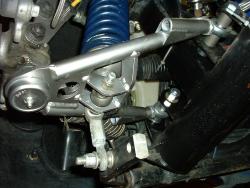
|
This was the first time I'd done a full front suspension alignment. Nate had always done it before, except earlier in the summer when I'd had a local tire shop do caster, camber and toe, and one or two previous occasions when I'd done toe-in only.
To enhance the accuracy of what I was doing, I fabricated a clamping mechanism that held my Longacre caster/camber gauge to the rim while I worked. This ensured much better repeatability, especially with the caster adjustment, since I could hold a straightedge on the gauge at each end of the 20° travel and align it with a chalk mark on the floor to make sure I was measuring the same thing every time.
I also built a bump steer gauge, which allowed me to accurately check the bump steer after setting the caster. Since I was doing this with the spring/shock units out of the car (pretty much a necessity if you want to check bump steer), I also made some adjustable droop stops to hold the suspension at ride height level while the car was up on jack stands.
Incidentally, I'd made one other small change to the front suspension. My Cobra is a Mark I, which means that camber and caster were originally set by moving the upper control arms' inner mounts back and forth in slots on the frame. The FFR Mark II design eliminates these slots in favor of a pair of holes at what would have been each end of the slots, and uses adjustable upper control arms like we installed on our car a couple of years ago.
However, the slots remain, and in the past we'd had the upper control arms move in these slots. Nate had addressed the problem by really socking down the clamping bolts, but I wanted a more positive solution. I made some plates with two holes in each plate, corresponding to the inner and outer ends of the slots. I bolted these plates in place with a short bolt through the inner hole, and the lower control arm mount through the outer hole. This makes it virtually impossible for the lower control arm mount to move; the plate would have to buckle or the bolts would have to shear.
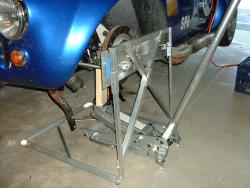 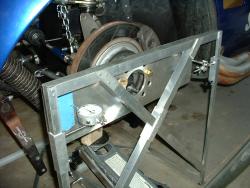 |
However, this turned out to be just fine, as we'll see below.
Incidentally, the fact that the rod ends allow some adjustment to the front track turned out to provide an unexpected benefit. With the rod ends all the way in, the arms are the same effective length as the stock arms. However, when I tried to get 2.5° camber and 6° caster, (remember that my upper control arms are now at the outer end of the slot, corresponding to a Mark II's outer hole) I didn't have enough adjustment on the upper control arms. To get the adjustment I wanted, the upper control arms would have needed shortening.
Instead, I just unscrewed each of the lower rod ends out 1/4". This gave me more static camber and allowed plenty of adjustment for whatever caster and camber I wanted within my maximum targets of 3° camber and 8° caster.
To my surprise, when I road-tested the car after the changes, the first thing I noticed was that the car rode better. I think this was due to the reduction in friction due to eliminating the urethane bushings, and also because I rebuilt the upper control arms, whose pivots were getting sticky.
More importantly, the car also
tracked effortlessly; all its old tendency to wander and snatch
over bumps and ruts was gone. Now it's one hand on the wheel -
a couple of fingers, really - at any speed. The car feels as solid
and stable at 120 mph as it does at 60.

|
As you may know, Loudon has a 1 mile oval used by NASCAR, but we usually we run a road course known as the Chicane-Chicane configuration. This configuration uses only the main straight of the oval and a small part of the back straight. At the ends of the oval, instead of running around the oval turns, we run through slower, twisty bits in the infield known as chicanes. Since these are slow corners lined by grass, the risk of damaging the car is very low.
However, when we use the South Oval configuration, we drive around the same fast, flat turn on the south end of the oval track that the NASCAR drivers use. It's a very fast 180° corner, taken at between 80 and 115 mph by most cars in our club.
On the outside of the south oval turn is a concrete wall. If you hit it, it will destroy your car and likely hurt you too. This year they've installed the same "soft wall" technology that they've been using at Indianapolis for the past couple of years, but it's "soft" only in the sense that it will reduce the severity of the impact and make you less likely to be seriously hurt if you hit it. Made of steel backed by foam, it will still destroy your car.
Anyway, the south oval is a very intimidating turn, and that makes it more difficult to approach the limit and get the best out of your car and yourself.
Last year my best time on the South Oval layout was a 1:16.9, and my brother Nate beat me by several tenths, with a 1:16.6. The guy who won the class did a low 1:16.1.
Over the course of the summer, I've made a number of improvements to the Cobra, including Kirkey racing seat and power steering. As I mentioned above, during past three weeks I worked hard on the new front lower control arms. The clock would tell if all that hard work (and money!) had paid off.
On the track, the improvement was immediately apparent. Turn-in was crisp, and I felt far more comfortable in the south oval than I ever had before. I concentrated on carrying more speed into turn 1 and getting the power back on earlier, and my lap times began to fall.
I was quickly under my previous best times from the year before. The first session was wet, but in the second session I ripped off a 1:15.84! By the end of the day on Saturday, I'd done several more laps in the high 15's, and in the final session, with a student on board (this usually costs at least a second), I'd managed a 1:16.4. It felt like there was more to come!
Tire temperatures confirmed the increased effectiveness of the revised front suspension, as did a change in the car's balance. Previously, the front tires always ran hotter on the outside edge. Now, for the first time, the inner and middle temps were higher than the outer! This meant the outside front tire was now laying flatter in the corner, working its contact patch more effectively and generating more grip.
A change in the car's handling on the track further confirmed this. In August, the car's balance had been excellent, with slight oversteer for the first couple of laps as the tires came up to temperature, after which it changed to very mild understeer in the slower corners and comfortably neutral behavior in the faster ones.
This weekend with the modified front suspension the car was oversteering everywhere, under all conditions. Clearly the front suspension was working better!
Saturday evening, to bring the balance back in line - and to let the previously under-utilized rear tires do more work, now that the fronts were doing their share - I backed off two notches on the rear anti-roll bar.
On Sunday, with properly balanced handling, we'd see what the beast would do!
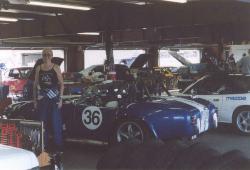
|
To understand the significance of these cars for me, you have to understand my passion for cars and especially for Cobras. I caught the fast car/racing bug when I was a kid, and at that time the Cobra was the fastest production car in the world. They were winning everywhere and on the cover of every car magazine. They looked gorgeous and were monstrously fast. They won the world championship in 1965 - and are still the only American car ever to have done that.
For someone like me, the Cobra was an impossible dream, the kind of thing you wanted with total passion, but knew you could never have.
Now I was looking at two gorgeous, wickedly fast Cobra replicas. Original, authentic Cobras are still out of reach (they are worth between $200,000 and $4,000,000!) but here were two guys who were building and racing their own replicas. And, with my brother's help, I was about to do the same.
However, even after my brother Nate and I built our car and began racing it with COMSCC, these other Cobra guys still had the unobtainable.
First of all, they built their cars from kits made by a company in Connecticut called ERA, which makes high quality, well-designed cars. Secondly, they had the same type of engines used in the most powerful of the original Cobras, known as a "big block". These engines make somewhere in the vicinity of 600 hp.
Third, both of them had been racing their cars for over 10 years, and had developed both their driving skills and their cars' handling to the point that they were extremely fast.
For the past three years, these two cars had been one of the standards against which Nate and I measured ourselves. We built our car from a kit which was engineered for low cost. To further minimize the cost, we used a stock "small block" engine which makes only 225 hp.
Since very few Cobra replica owners ever drive their cars hard, handling was low priority in the design of these kits. As originally built (to the factory instructions) our Cobra's handling and cornering capabilities were, to put it bluntly, poor. With ultra-soft springs and shocks, the car wallowed badly in corners and pitched and heaved dramatically in response to any throttle or brake application. The large chassis movements amplified various suspension geometry issues, which resulted in inefficient use of the tires and made the car darty and unstable. In short, the car was difficult to drive and had much less cornering power than it could have.
These and other factors (such as inadequate brakes) made us much slower than those two mighty big block Cobras. But over the past three years, with the guidance of a friend, Doug Arnao, who prepares Porsches for the track, we slowly improved our car's handling.
We made one change after another, as we could afford it, and gradually improved a car that handled like a pig into a rocking, roaring ferocious tiger. It still has only 225 hp, but we believed that on tight, twisty road courses like Loudon, what matters most is how fast you get through corners, not how fast you accelerate once you're out of the corners.
Over time, the effort paid off, and the gap in lap times between us and those mighty big block Cobras shrank. During the past couple of years, most of my best lap times have been done while chasing either the gray ERA Cobra or the red one, trying to keep up. At Loudon I could stay with them until their tires got warm, but then they'd begin to pull away, their hugely superior acceleration giving them an advantage that my car's handling couldn't quite overcome.
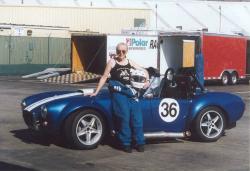
|
Once past the Lotus, I put my head down and drove as hard as I could. My second flying lap was a 1:14.7 - over two seconds faster than my best time last year! At the level we're running, this is a huge difference; the faster you're going, the harder it is to find more time.
At the end of the lap, I'd caught the gray Cobra. I camped on his tail for a couple of laps, and then he waved me by. I blew away from him, but then we caught a huge group of other cars. As I worked my way by, the gray Cobra kept poking his nose alongside me on the straight (he still has over twice as much horsepower as I do) so I waved him past me.
That was a big mistake. Once we worked through the traffic, the gray Cobra was holding me up. I was never able to get close to my earlier 1:14.7 because he was doing 1:16's, but he was much faster on the straight so I couldn't pass him.
It was frustrating, because I felt I could have gone even faster if I'd had a clear track.
But it was also immensely rewarding! To find yourself capable of going so fast that you are being seriously held up by a car and driver that once seemed to be the unobtainable - that's an amazing feeling!
To further underline how far I've come, the owner of the red big block Cobra offered to let me drive his car - and wanted to try mine! It didn't work out this weekend, but we plan to do it at Lime Rock in November.

|
She is right! The most important goal is to finish without crashing. The next most important thing is to finish and not break the car. Then you need to do the best lap time you can.
I managed the first two, while my rival for the championship (a very nice fellow named Gregg Metzger, who drives a Mustang) was unfortunate in having his clutch fail in practice, so he couldn't run the time trial.
However, I didn't manage the third goal. I didn't do the best lap time I could.
As you probably know, we get three timed laps, and the fastest of these laps is the one that counts. My strategy is to do a somewhat conservative first lap in my timed run, and then go harder for the second and third laps. That way, a decent time from the first lap is "in the bank", so if I spin or make a big mistake on the later laps due to going to hard, I've still got a decent time from the first lap.
On Sunday, for some unknown reason, on the first lap, I missed a shift in a place where I'd never missed one before: the entry to Turn 6. This made me slow out of a very critical corner, so the lap was blown (it was a low 1:16). Then, on the second lap, I missed the same shift!! Augh!! This lap was even slower!
Finally on the third lap I got it right, but because I didn't have a "banker" lap, I had to be a little conservative. I managed only a 1:15.4.
My 1:15.4 was fast enough for second in class, and the 1:14 I was hoping for wouldn't have gotten me a first place trophy anyway, because the winner did a 1:13. But it was still frustrating to not have done my best when the official clock was on. That's the first time in several events that I haven't done my best time of the weekend on the third lap of the time trial.
The class winner's time, by the way, was also the fastest time of the day. He represents another "unobtainable". His name is Bruce Allen, and he's one of the best drivers in COMSCC. He regularly wins in SCCA, which is an even tougher club than COM.
Bruce's car, known as a Lotary 7, is a marvel of modern engineering. It uses the same concept as my Cobra: start with a high performance street car, and take all the important parts (engine, transmission, suspension, wiring harness, computer, etc.) and put them in a much smaller, lighter chassis.
But in Bruce's case, he started with a car (a third generation Mazda RX7) which is vastly superior to my Cobra's "donor car" (a '91 Ford Mustang). Bruce's light weight twin turbo rotary engine makes somewhere over 350 hp, and his suspension, beautifully engineered and exquisitely built out of aluminum by an expert team of enthusiasts at Mazda, is vastly superior to the heavy, relatively crude steel and iron bits from the Mustang that I started with.
Even more crucially, Bruce's Lotary chassis is much lighter; his tiny car weighs 1800 lb versus my Cobra's 2300 lb. In road racing, weight is critical, so those 500 pounds are a huge handicap.
I know I'm never going to beat Bruce's Lotary with my Cobra, but it is satisfying to be getting closer. In fact, if I'd managed a 1:14 in the time trial, I like to think I might have given Bruce a little bit of a scare!

|
I'd driven the Esprit with Mike at Mosport in June, and liked it. In June I found its handling to be very similar to my Cobra's but it was a little softer and rolled a bit more in the corners, and it seemed to be somewhat more forgiving.
Yesterday, however, the Lotus seemed cumbersome and heavy compared with the Cobra. Since June I'd installed power steering in the Cobra. Other modifications to the front suspension make its handling more responsive and increase its grip.
Now the Cobra's steering is light and quick, and driving the Cobra at its limit seems relatively effortless. By comparison the Lotus' steering seemed very heavy and slow.
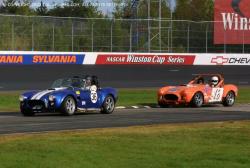
|
The Lotus is a very powerful megabuck supercar built by a company renowned for its cars' handling, but I prefer my Cobra!
Also during the open practice, I offered to let John Spain drive my Cobra. John and my brother Nate own a Miata which they are racing this season, but John's interested in getting a Cobra, so he was very glad to try my car. He loved it! He had a grin a mile wide when he got out of the car.
Nate, who hasn't driven the Cobra since last November, also tried it for a few laps, and he also found it to be delightful - and he said his Miata felt very weird after the Cobra!
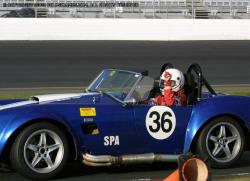
|
Also, because the car is handling better, I feel that I'm driving better because I have more confidence in it.
I'm now leading the championship by 15 points. With only 22 points available from the remaining two events, things look promising! A good finish at Loudon in October could clinch it.